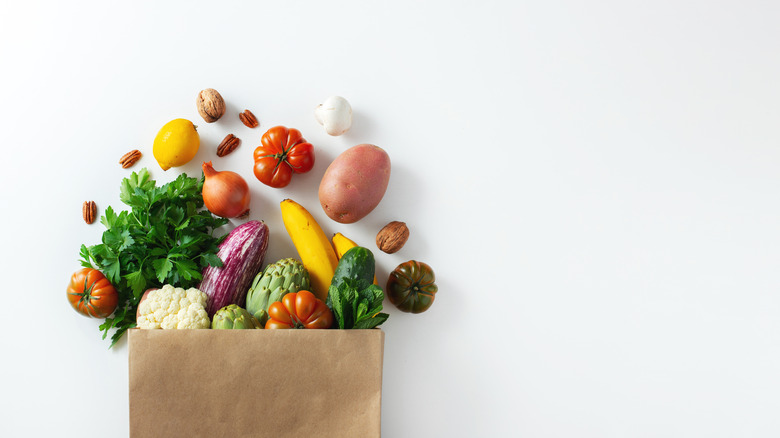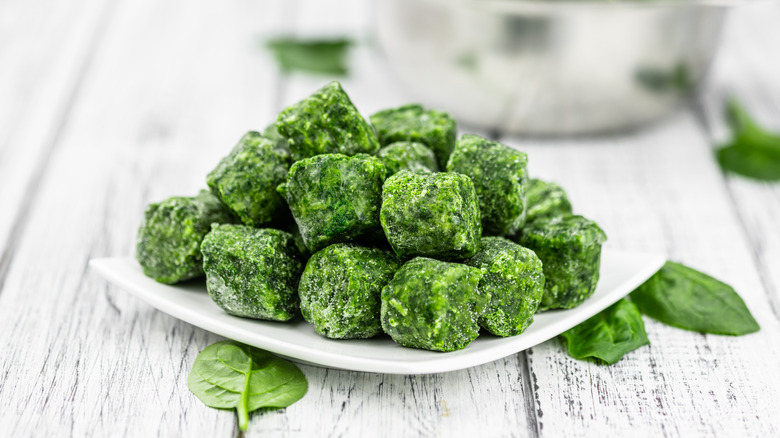How To Shop For Nutritious Foods On A Budget, According To An RD
The importance of a healthy diet can hardly be overstated. A diet that is hgh in fruits and vegetables has not only been linked to a number of improved health outcomes, including reduced risk of cancer, high blood pressure, heart attacks, and strokes (per the Harvard T.H. Chan School of Public Health), but it has also been shown to have a significant impact on our moods. Studies have shown that eating a nutritious diet has been linked to better mental health, due to the fact that many important neurotransmitters that affect mood are actually produced in the gut, according to Healthline.
However, eating healthy can be a lot easier said than done. It can be difficult to find affordable, fresh food on a budget, not to mention the fact that finding the bandwidth to whip up a healthy meal from scratch when one is already strapped for time can be a struggle for many families. Fresh fruits and vegetables also have a much shorter shelf life than canned, processed, or preserved foods, meaning they are more likely to go to waste if not prepared quickly, which is essentially the equivalent of throwing money right in the trash can.
All of these can be barriers to entry when it comes to households trying to improve their diet on a budget, but there are still ways to eat nutritious foods without breaking the bank.
A high-volume diet can be both healthy and cost-effecient
One strategy experts recommend for eating healthy, even on a budget, is a technique called volume eating. Volume eating is "an eating strategy that allows for high volume dishes with less of a concern for overconsumption of calories," registered dietitian and MyFitnessPal nutrition consultant Brookell White MS, RDN, explains to Mashed.
Some foods, such as candy, processed foods, or foods that are high in sugar or fat, provide a very low amount of macronutrients when compared to their calorie content, according to Kay Nutrition. On the other hand, high-volume foods are nutrient-dense without being high in calories.
Many high-volume foods, such as spinach, kale, broccoli, and berries, are high in fiber, water, and other nutrients, and can help you feel full for long periods of time on a fairly low number of calories. However, White cautions that just because a food is high-volume doesn't mean it's "cost-efficient." While high-volume foods are a great way to consume protein, fiber, and other healthy nutrients, in large quantities without overeating, they aren't always budget-friendly.
High-volume foods can be frozen
However, there are ways to eat high-volume foods without overspending. Some ways to save money while still eating healthy include planning out meals ahead of time and being mindful of not purchasing foods that will go bad within a week, per the Harvard T.H. Chan School of Public Health.
While that can be tricky when purchasing fresh fruits and vegetables, Brookell White MS, RDN, advises purchasing fruits with a long shelf life, such as apples. She also recommends buying fruits that can easily be frozen and kept for a longer period of time, such as fresh berries and leafy vegetables like spinach and kale. "You can buy bulk quantities of either spinach or kale and freeze what you don't use. Cooking them also shrinks the greens significantly and is a great way to significantly improve the nutritional value of your meals. They can be used in many different ways and in all types of dishes," she explains.
White also advises adding healthy protein for a well-balanced diet. But like fresh veggies, fresh meat can also become somewhat costly. Instead, White recommends "cost-effective alternatives" such as "canned fatty fish such as salmon, tuna, mackerel, herring, and sardines," which "are great because they are high in both fat and omega-3s." Non-meat protein alternatives, such as eggs, beans, lentils, yogurt, and tofu, can also be cheap and easy ways to round out a healthy, high-volume diet.


